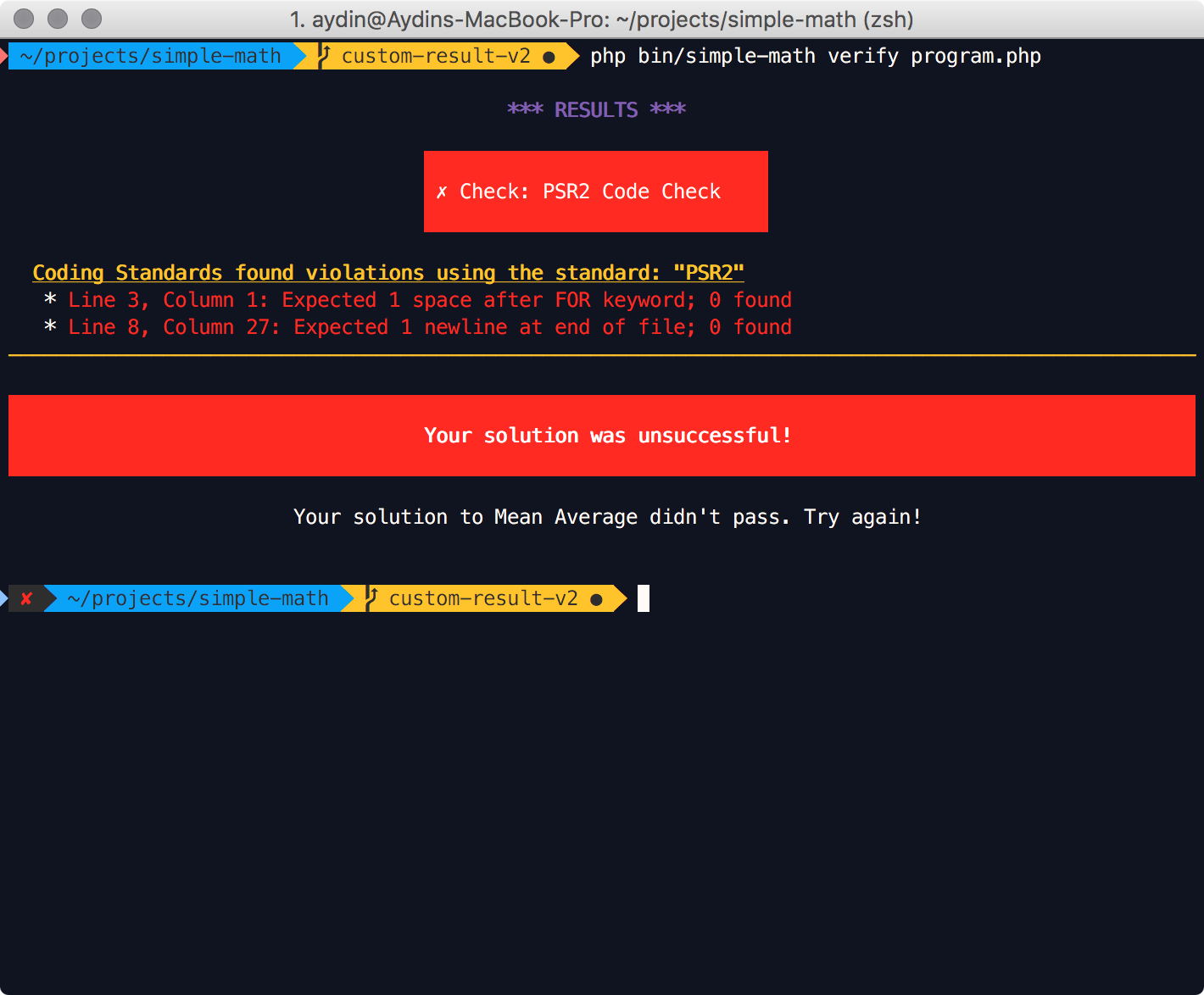Open Menu
Documentation Home
Workshop Tutorial
- Workshop Tutorial
- Creating your own workshop
- Modifying the theme of your workshop
- Creating an exercise
Reference Documentation
- Reference Documentation
- The Container
- Available Services
- Exercise Types
- Exercise Solutions
- Results & Renderers
- Exercise Checks
- Bundled Checks
- Creating Simple Checks
- Creating Custom Results
- Creating Custom Result Renderers
- Events
- Creating Listener Checks
- Self Checking Exercises
- Exercise Events
- Patching Exercise Submissions
Creating Custom Result Renderers#^ TOP
If you don't know what result renderers are, go ahead and read this article first. We will be continuing on from the previous article, let's go ahead and create the renderer.
1. Create the folder and class
mkdir src/ResultRenderer
touch src/ResultRenderer/CodingStandardFailureRenderer.php
2. Write the renderer class
<?php
namespace PhpSchool\SimpleMath\ResultRenderer;
use PhpSchool\PhpWorkshop\ResultRenderer\ResultRendererInterface;
use PhpSchool\PhpWorkshop\ResultRenderer\ResultsRenderer;
use PhpSchool\SimpleMath\Result\CodingStandardFailure;
class CodingStandardFailureRenderer implements ResultRendererInterface
{
/**
* @var CodingStandardFailure
*/
private $failure;
/**
* @param CodingStandardFailure $failure
*/
public function __construct(CodingStandardFailure $failure)
{
$this->failure = $failure;
}
/**
* @param ResultsRenderer $renderer
* @return string
*/
public function render(ResultsRenderer $renderer)
{
$header = sprintf(
'Coding Standard violations were found using the standard: "%s"',
$this->failure->getCodingStandard()
);
$output = [
sprintf(' %s', $renderer->style($header, ['bold', 'underline', 'yellow'])),
];
foreach ($this->failure->getErrors() as $error) {
$output[] = ' * ' . $renderer->style($error, 'red');
}
$output[] = '';
return implode("\n", $output);
}
}
This is really simple: the render(ResultsRenderer $renderer) just returns a string
representation of the result, we style the results a little in a bullet pointed list, highlighting them red.
We also add a title which describes the coding standard used.
That's basically it - we just need to register the renderer with the application.
3. Register the renderer
Now you need to tell the application about your new result. Open up app/bootstrap.php and
after the application object is created you just call addResult with the result class name
and the result renderer class name. Your final app/bootstrap.php file should look something like:
<?php
ini_set('display_errors', 1);
date_default_timezone_set('Europe/London');
switch (true) {
case (file_exists(__DIR__ . '/../vendor/autoload.php')):
// Installed standalone
require __DIR__ . '/../vendor/autoload.php';
break;
case (file_exists(__DIR__ . '/../../../autoload.php')):
// Installed as a Composer dependency
require __DIR__ . '/../../../autoload.php';
break;
case (file_exists('vendor/autoload.php')):
// As a Composer dependency, relative to CWD
require 'vendor/autoload.php';
break;
default:
throw new RuntimeException('Unable to locate Composer autoloader; please run "composer install".');
}
use PhpSchool\PhpWorkshop\Application;
use PhpSchool\SimpleMath\Check\Psr2Check;
use PhpSchool\SimpleMath\Exercise\Mean;
use PhpSchool\SimpleMath\Result\CodingStandardFailure;
use PhpSchool\SimpleMath\ResultRenderer\CodingStandardFailureRenderer;
$app = new Application('Simple Math', __DIR__ . '/config.php');
$app->addExercise(Mean::class);
$app->addCheck(Psr2Check::class);
$app->addResult(CodingStandardFailure::class, CodingStandardFailureRenderer::class);
$art = <<<ART
∞ ÷ ∑ ×
PHP SCHOOL
SIMPLE MATH
ART;
$app->setLogo($art);
$app->setFgColour('red');
$app->setBgColour('black');
return $app;
Try it out!#^ TOP
Run the workshop and select the Mean Average exercise. Verifying a solution which does not pass the
PSR2 coding standard will yield the following output:

You can see the finished, working code on the custom-result branch of the
tutorial repository.